 |
 |
 |
| |
Alisporivir Plus Peg-IFN_-2a/Ribavirin Treatment for Chronic Hepatitis C Genotype 1 Treatment-Naïve Patients
Shows Superior Sustained Virologic Response Irrespective of IL28B Genotype and High Barrier to Resistance
|
| |
| |
Reported by Jules Levin
HEPDART 2011; December 6, 2011; Koloa, Hawaii
Flisiak R,1 Pawlotsky J-M,2 Crabbé R,3 Calistru PI,4 Kryczka W,5 Haüssinger D,6 Mazzella G,7 Romero-Gomez M,8 Purcea D,3 Vuagniaux G,3 Bao W,9 Avila C,9 Zeuzem S,10 Rasenack J11
1Medical University of Bialystok, Poland; 2Hopital Henri Mondor, Créteil, France; 3Debiopharm, Lausanne, Switzerland; 4Centrul de Diagnostic si Tratament "Dr Viktor Babes," Bucharest, Romania; 5Dept of Infectious Diseases, Provincial Hospital, Kielce, Poland; 6Universitätsklinikum, Düsseldorf, Germany;
7Dept of Internal Medicine and Gastroenterology, University of Bologna, Italy; 8UCM Digestive Diseases and Ciberehd, Hospital Universitario de Valme, Sevilla, Spain; 9Novartis, Basel, Switzerland; 10Dept of Internal Medicine I, JW Goethe University Hospital, Frankfurt/Main, Germany; 11Albert Ludwigs University, Freiburg, Germany
AASLD: Once-daily alisporivir interferon (IFN)-free regimens achieve high rates of early HCV clearance in previously untreated patients with HCV genotype (G) 2 or 3 - (11/09/11)
AASLD: Novartis DEB025 data showed viral clearance as early as six weeks and potential for interferon-free therapy in hepatitis C patients - (11/07/11)
EASL: Once daily alisporivir (DEB025) plus Peg-IFN-alfa-2A/ ribavirin ...
www.natap.org/2011/EASL/EASL_08.htm
Apr 3, 2011 - Once daily alisporivir (DEB025) plus Peg-IFN-alfa-2A/ ribavirin results in superior sustained virologic response (SVR24) in chronic hepatitis C
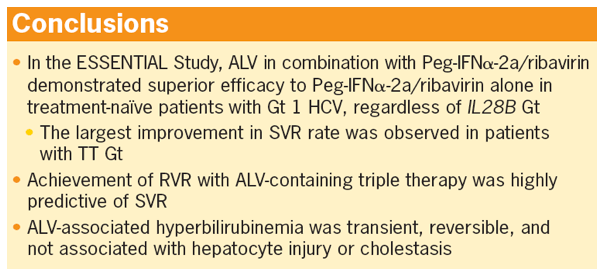
ABSTRACT
BACKGROUND: Alisporivir (ALV), the most advanced oral cyclophilin inhibitor using a host targeting antiviral (HTA) for treatment of HCV infection was studied in a multinational, double-blind, randomized, placebo-controlled trial to evaluate its efficacy and safety combined with PegIFNalfa2a/ribavirin (PR) in genotype 1(G1), treatment-naïve chronic hepatitis C patients.
METHODS: An ITT population of 288 patients were randomized to receive ALV+PR for 48 weeks (ALV48), ALV+PR for 24 weeks (ALV24), ALV+PR in response-guided treatment (ALV-RGT) of 24 weeks for RVR (rapid virologic response: HCV-RNA ≤10 IU/mL, Roche Cobas Taqman after 4 weeks of treatment) and 48 weeks for non-RVR patients, or ALV-placebo+PR for 48 weeks (PR48). ALV was administered 600 mg twice a day for the first week (loading dose), followed by once daily dosing.The primary endpoint was sustained virological response at 24 weeks (SVR) of follow-up. Additionally factors predicting SVR were analyzed.
RESULTS: Viral load, BMI, age, sex and race were balanced at baseline. SVR was 76% in the ALV48 arm vs 55% in PR48 arm (p=0.008) despite a significantly lower prevalence of IL28B CC genotype (20% vs. 33%). A similar SVR rate was achieved in ALV24 and PR48 arms. Achieving RVR was 100% predictive of SVR24 for the ALV48 and ALV-RGT arms. Among patients with high baseline viral load (HCV RNA >600,000 IU/mL) SVR was achieved in 68% of the combined ALV48 and ALV-RGT arms vs. 47% in PR48 arm. ALV in combination with PR treatment had a low viral breakthrough (VB) rate (2.8%) and no genotypic change was consistently associated with VB.
Virological response analysis by IL28B genotype showed that RVR was achieved in higher proportions of ALV patients regardless of IL28B genotype (CC: 67%; CT: 11%; TT 11%) vs control (CC: 27%; CT: 0%, TT: 0%). 100% of CC genotype patients from ALV48 and ALV-RGT arms had undetectable HCV RNA by Week 12 and achieved SVR (vs 73% PR48). Among ALV48 and ALV-RGT TT genotype patients, SVR was achieved in 68%(19/28) vs 17%(2/12) in PR48 (P=0.0158). Multivariate logistic regression analysis demonstrated lower baseline viral load, younger age and RVR are all significant predictors of achieving SVR. ALV containing therapy was well tolerated. Transient and reversible hyperbilirubinaemia without any increase of ALT or GGT was associated with the loading dose.
CONCLUSIONS: Alisporivir in combination with PegIFN/RBV demonstrates high barrier to resistance and superior efficacy compared to PegIFN/RBV for treatment-naïve patients infected with G1 HCV regardless of IL28B genotype. The largest improvement of SVR rate was demonstrated in TT genotype patients. Achievement of RVR with ALV containing triple therapy was highly predictive of SVR. ALV associated hyperbilirubinaemia was transient, reversible and not associated with hepatocyte injury or cholestasis.
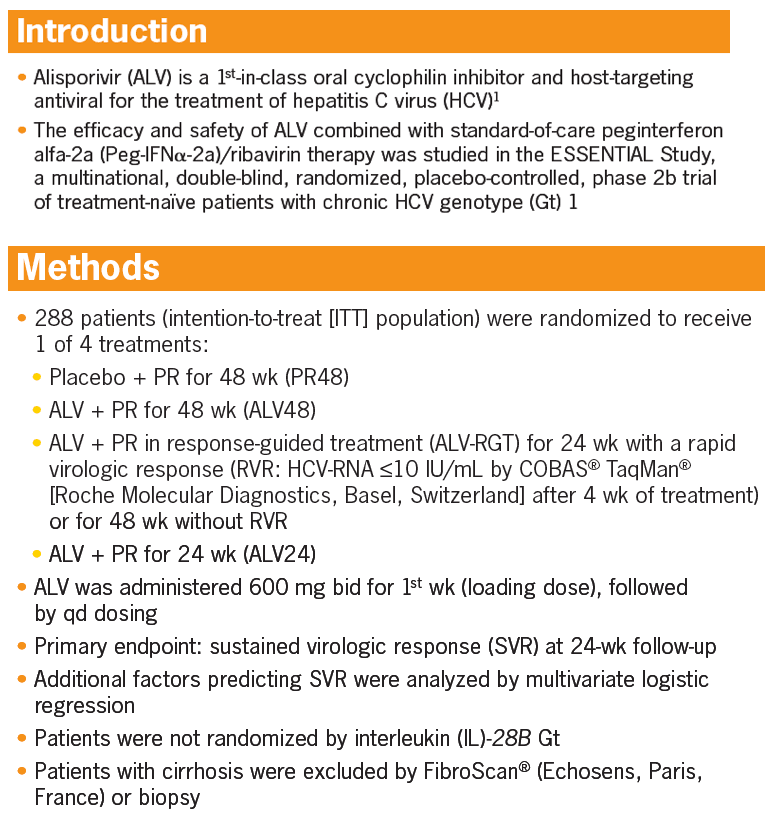
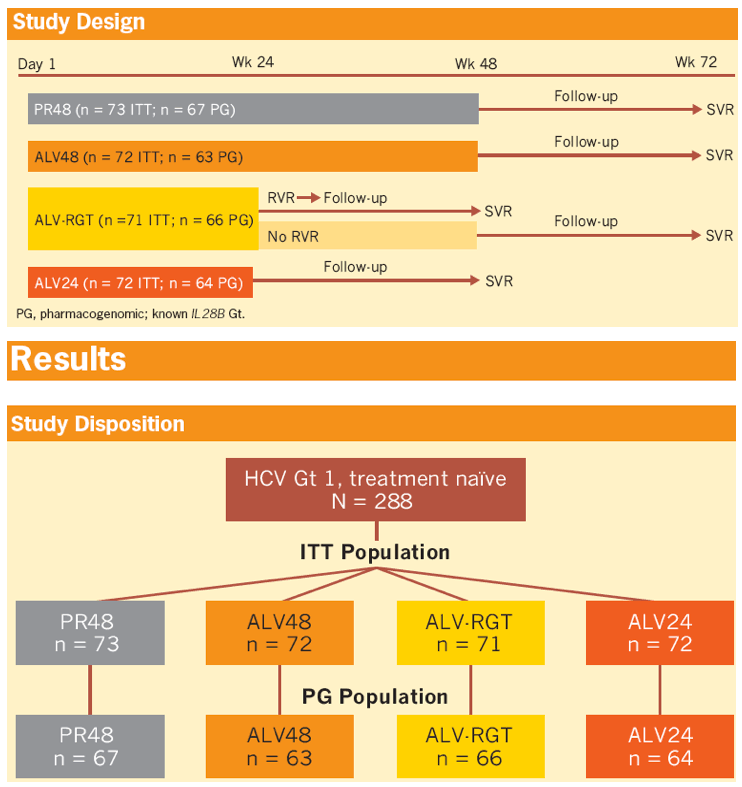
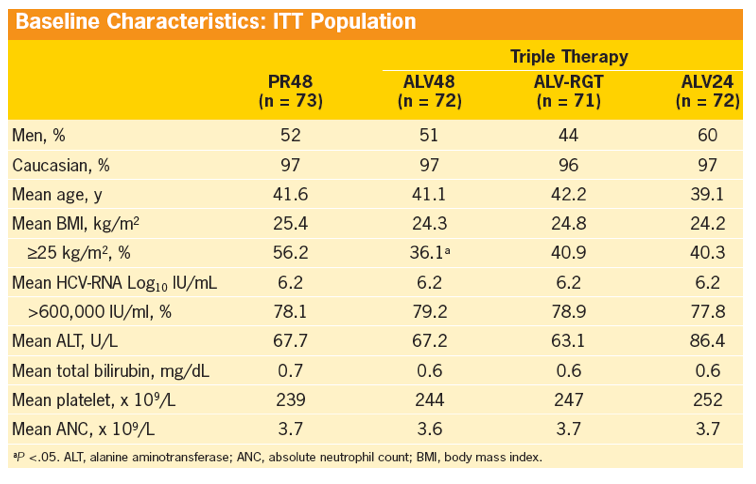
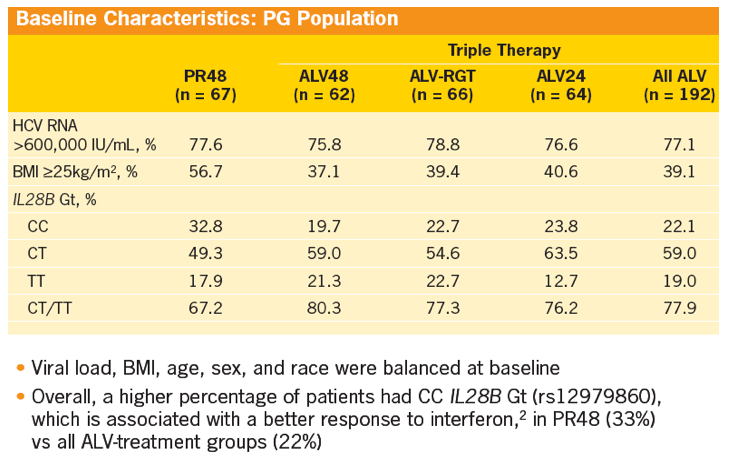
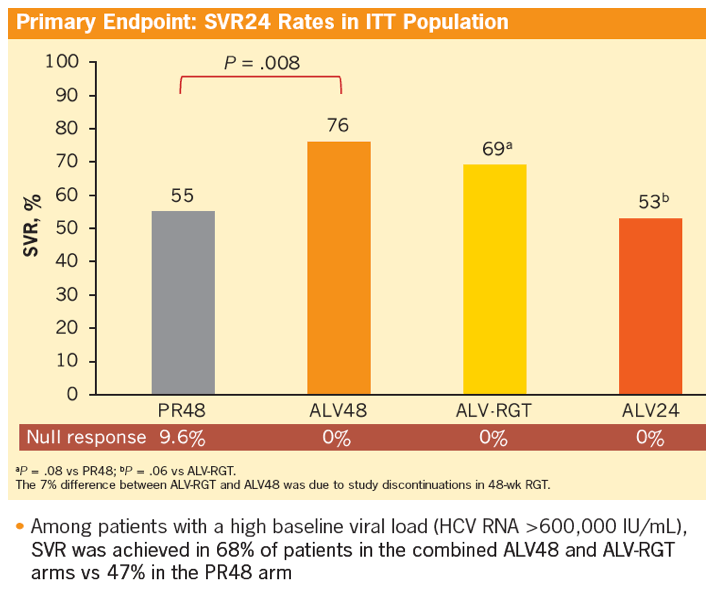
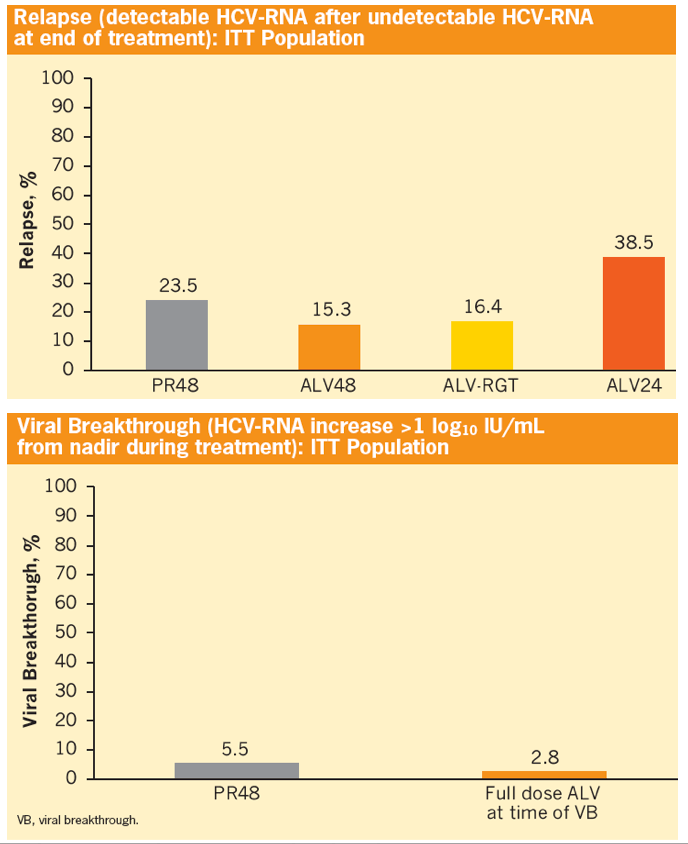
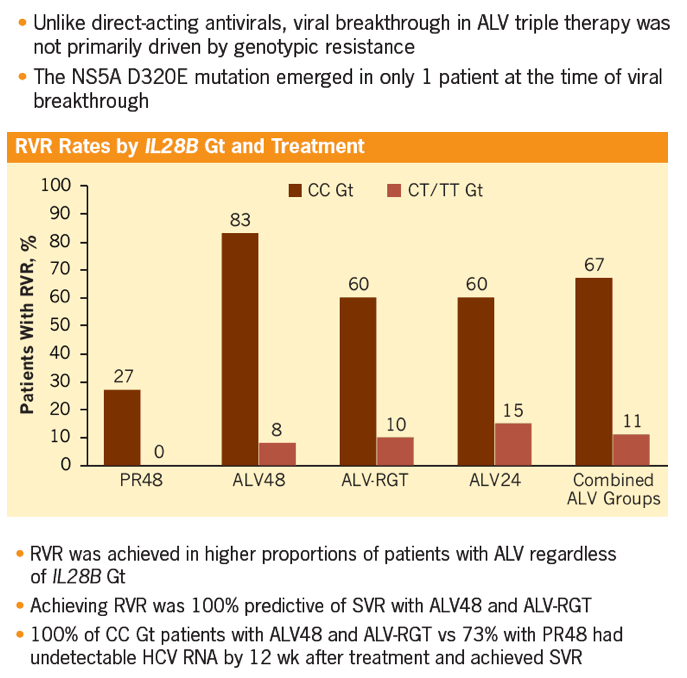
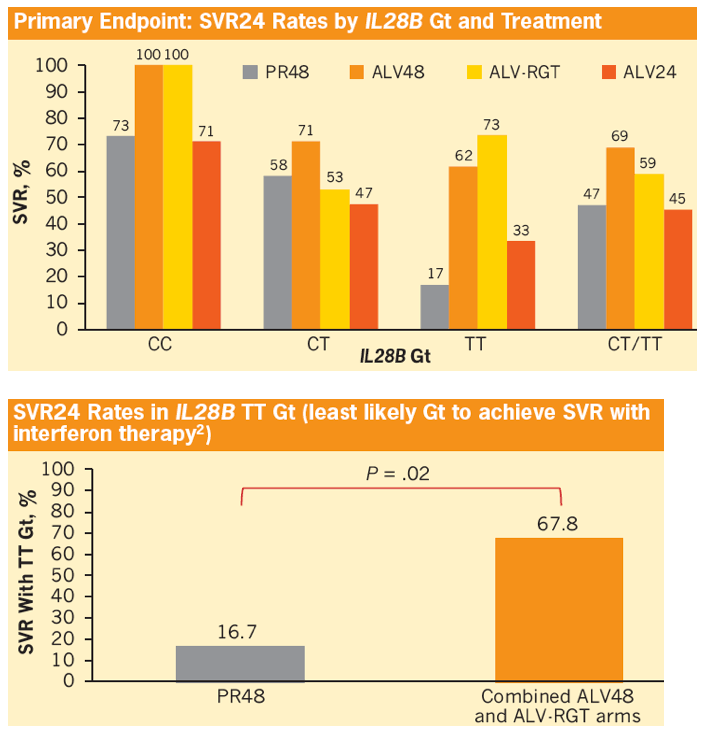
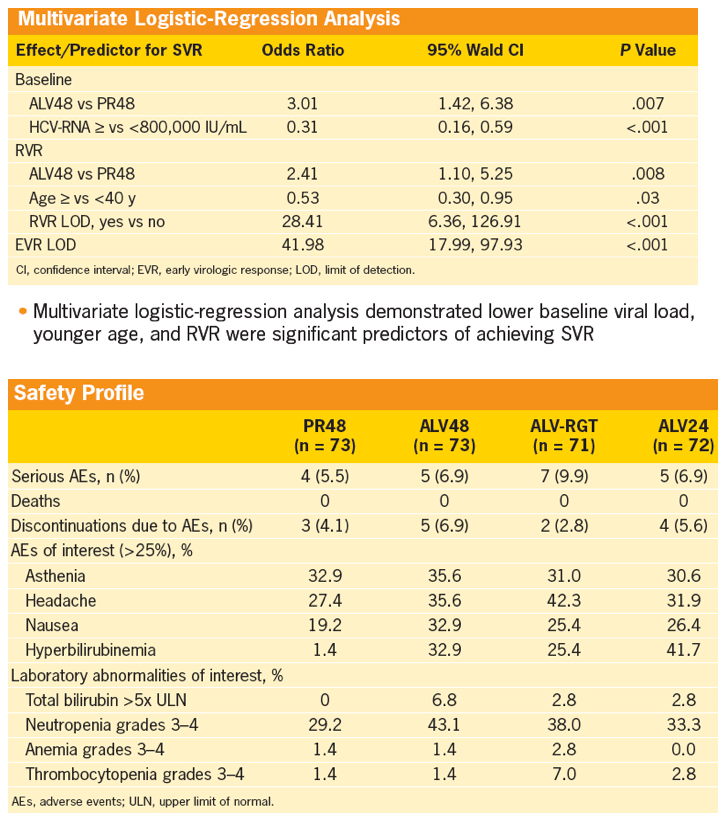
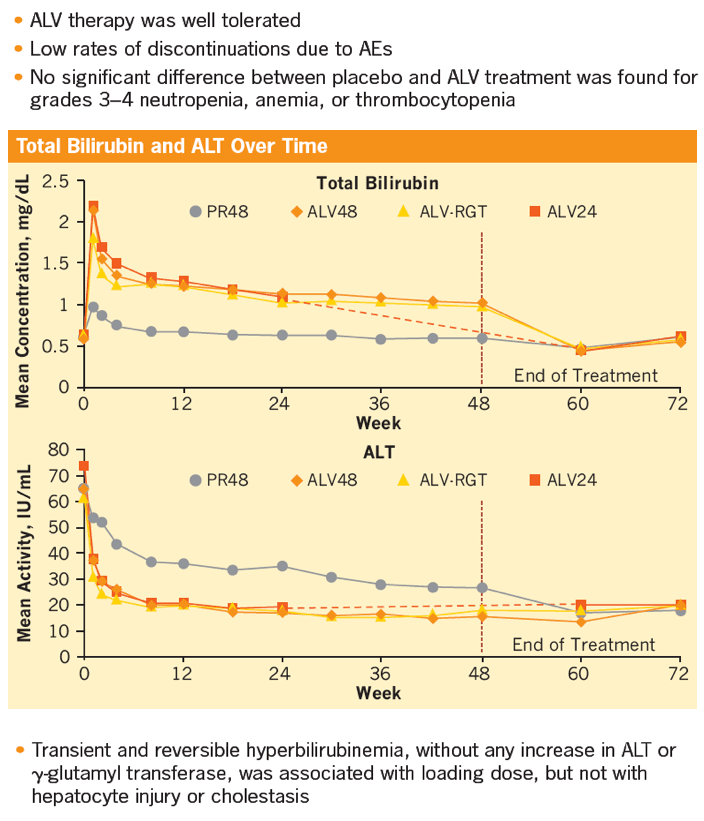

|
| |
|
 |
 |
|
|